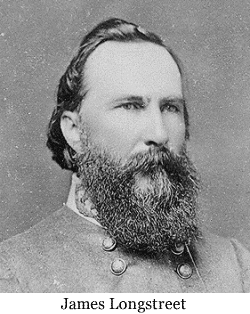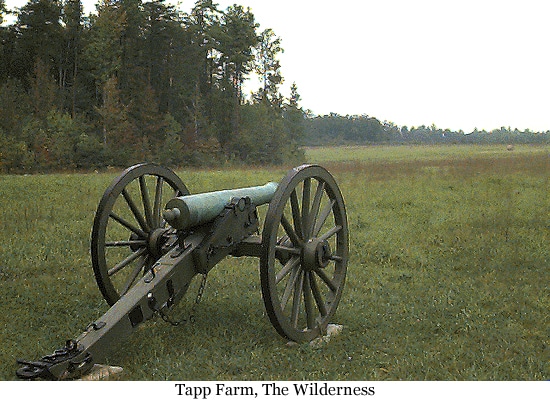From the Wilderness to Atlanta
That man [Grant] will fight us every day and every hour till the end of the war.
–James Longstreet to Robert E. Lee

Lincoln liked immensely the new general-in-chief’s way of thinking. In the past, Grant argued, northern armies had “acted independently and without concert, like a balky team, no two ever pulling together.” This lack of concert had allowed the Confederacy to reinforce at threatened points. Longstreet, for example, had been sent both to Suffolk in southern Virginia and Chattanooga in Tennessee while Lee held the line in northern Virginia. To win the war, Grant was sure, the North had to sustain the pressure on all fronts until it became unbearable. Seizing and holding territory meant nothing, and even less than nothing because holding it demanded manpower to guard it. The only thing that mattered now was the destruction of Southern armies and the agriculture and industry that sustained them. Conquest, Grant had concluded after Shiloh, was the only way to end the rebellion. Meade in the East received pointed instructions: “Lee’s Army will be your objective point. Wherever Lee goes, there will you go also.” (Lincoln must have felt relieved to find at last a general who didn’t blather about what he would do when he got to Richmond.) Sherman in the West was to “move against Johnston’s army, to break it up, and to get into the interior of the enemy’s country as far as you can, inflicting all the damage you can against their war resources.” Again, the objective was the Rebel army, not Atlanta. Elsewhere Nathaniel Banks in Louisiana would drive on Mobile, Benjamin Butler would drive up the James River and breach the line between Richmond and Petersburg, and Franz Sigel would drive up the Shenandoah Valley and cut Virginia west of the Blue Ridge off from Lee. It was just the sort of design Lincoln had been urging all along. As the former farmer’s boy from Kentucky put it now, “Those not skinning can hold a leg.” There was one catch, though. The beast had best be skinned before the November election.
On the face of it, then, a simple and straightforward plan. On paper, the North had a two-to-one manpower advantage. Use that strength vigorously and the South must inevitably, as Josiah Gorgias had written, totter toward destruction. In fact the situation was not as straightforward as it appeared on paper, however. The Confederacy, desperate for manpower, had first established conscription. Now the Confederate Congress abolished its original provision for paid substitution and expanded the reach of the draft from age 17 to 50. Further, the original three-year men were now required to serve for the duration. Thus, Southern armies would be reinforced to the extent that they could, and, perhaps more important, they would retain their hard, tested, veteran core. Southern armies in ’64 would fight on the defensive, on interior lines, and on their own soil. There was no question in anyone’s mind that they were a dangerous fighting force, and it might be that they didn’t even need to win. It might be enough simply to be still in the field and dangerous when Northerners went to the polls in November. For the North, the problem was roughly thus: although it had an edge in manpower, as an invading force it urgently required that edge and needed to maintain it. Each success ironically meant that more and more men must be detached from the fighting fronts to garrison conquered territory and guard supply lines. For the Federals, what is today known as an army’s “logistical tail” grew longer and more vulnerable the farther south it advanced. To maintain numerical strength Congress passed two measures that somewhat changed the character of Union armies. The enlistments of the three-year men, the tough fiber of Union strength, were expiring this summer. The Confederate Congress had simply expanded conscription of civilians and extended by law the service of its three-year men. The Union Congress, mindful of the draft riots of ’63, attempted to attract new recruits and retain veterans by the offer of cash bounties and other inducements. Veterans were offered a cash bonus, thirty days’ furlough, and the chevron of a Veteran Volunteer. In the end, more than half of all veterans reenlisted–136,000–though just half in the much-bloodied Army of the Potomac. (One soldier who declined reenlistment said wryly that he didn’t want to monopolize all the patriotism there was, but was willing to give others a chance.) Many of the others who came into the Federal armies by inducement of the bounty system were of doubtful quality as soldiers, mainly “gamblers, thieves, pickpockets, and blacklegs,” in the judgment of one Pennsylvania officer. As far as he was concerned, the fact that these bounty men deserted by the dozens was “thanks to a kind Providence.” Without question, the Federal armies about to march this spring would not be quite what they were the summer before.
There was another and, in the end, a more significant consequence of the politics of war in the North in 1864. The Lincoln government, looking ahead to the November elections, felt obliged to retain three generals who owed their commissions more to their political influence than their military skill: Nathaniel Banks, Ben Butler, and Franz Sigel. Grant’s conception was sound; their execution of it would leave much to be desired. First to act and first to fail was Nathaniel Banks. He dressed the part of a soldier faultlessly, one thought, but he was no stranger to failure. Back in the Valley in ’62 Jackson had used him so badly and helped himself to his supplies so freely that he had earned an unfortunate name: Commissary Banks. His troubles now were not entirely of his own making, however. Grant’s original plan called for him to move directly on Mobile, but the Lincoln government, wary of Napoleon III’s designs in Mexico and eager to seize Southern cotton, sent him first up the Red River to the west and eventually, it was hoped, into east Texas. His 20,000 would be stiffened by 10,000 men on loan from Sherman and supported by David Porter’s gunboats. Banks hadn’t got far–he was still 35 miles southeast of Shreveport–when, on April 8, 15,000 men under Richard Taylor struck his lead elements a swift and savage blow at Sabine Crossroads. (Taylor was the son of Zachary Taylor and had studied the art of war under Stonewall in the Valley.) Banks was sent flying back downriver to Pleasant Hill, where his men made a firm stand the next day. Their commander, however, seemed to have come unstrung by the first day’s repulse and ordered a retreat. Indeed, so precipitous was the withdrawal that Porter’s gunboats were very nearly left behind to their fate. The Red River had fallen dangerously low that spring, and it looked for a time that they might be beached and destroyed at the Rebels’ leisure. But a tough regiment of Wisconsin lumbermen improvised a series of dams that raised the water level just enough for Porter to escape over the rapids at Alexandria. Not until May 26, by which time Grant and Sherman had been engaged in three weeks of hard campaigning, did Banks return to southern Louisiana, no closer to Mobile than when he started. Except for bringing home a few bales of cotton, all Banks had done was to give Taylor’s 15,000 men an opportunity to go to Joe Johnston’s aid in Georgia and to keep 10,000 bluecoats from Sherman. In the end, Banks was shelved as a field commander and sent on to a desk job in Baton Rouge.
Franz Sigel was a Prussian-trained soldier who enjoyed no more success than the amateur Banks. His assignment now was to take his 6,500 men up the Shenandoah Valley to Staunton, Virginia. From Staunton ran a gap eastward through the Blue Ridge, and through that gap supplies from the still-productive Valley went to Lee on the far side of the mountains. Holding that place would also put pressure on Lee’s flank. The problem was that Sigel never got there. At New Market on May 15, he was struck by a hastily gathered force of 5,000 under former Vice President John C. Breckinridge, including 247 cadets of the Virginia Military Institute. The boy soldiers made their first attack that day and won a full measure of glory. Sigel made what turned out to be his last retreat. Although Lincoln might lose some of the German vote, he relieved Sigel from command shortly thereafter.
The greatest opportunity and hence greatest failure fell to Ben Butler, the Massachusetts Democrat some thought looked like a barrel with limbs. Butler was heartily despised throughout the South, where he had earned two unsavory nicknames: “Spoons” for allegedly stealing silverware in New Orleans and “Beast” for his harsh treatment of civilians. A rare luxury in the South were chamber pots with the squinty-eyed likeness of Ben Butler in the bottom. Still, the opportunity before him now was none other than the most cherished Federal pipe dream: seizing Richmond itself. With 30,000 men he steamed up the James unopposed and marched straightaway to the railroad halfway between Petersburg and Richmond on May 5. With Lee already locked in a death-grip with Grant in the Wilderness, there was nothing to prevent him from taking Richmond but 5,000 Confederates and a handful of government clerks carrying a musket for the first time. But, as so often before in the Federal armies, when the situation demanded swift and decisive action, Butler dragged his feet. He wasn’t ready to take his whole force north to Richmond until May 12, and by then Pierre Beauregard had brought up veterans from the Carolinas to bar the way. Butler got as far as Drewry’s Bluff, eight miles from Richmond, where Beauregard attacked on May 16. In short, the day after Sigel was routed in the Valley, Butler was driven in a bloody battle back to his trenches across a neck of land between the James and Appomattox Rivers known as Bermuda Hundred. Here he remained, in Grant’s words, “as… in a bottle stoutly corked.” Butler remained ineptly in command until the November elections, when Grant and Sherman’s successes deflated his political value and he was eventually relieved. The simple upshot of the three abortive campaigns–Banks’, Sigel’s, and Butler’s–was that if any skinning was to be done, Grant and Sherman were going to have to do it.
Grant’s plan was to march south in Virginia in concert with Sherman’s southward thrust in Georgia, both jumping off on May 4. The Army of the Potomac and the Army of Northern Virginia had camped the winter out on opposite banks of the Rapidan River quite peacefully, pickets on opposite banks keeping up a brisk and amiable commerce, Yankee coffee for Rebel tobacco, Northern newspapers for Southern. This spring, though, Grant’s 115,000 men and Lee’s 64,000 were about to march back to war, and this time to war unlike anything they had yet experienced and endured. There had been savage fighting to be sure, that terrible day at Antietam, two bloody days at Stones River, three days of fury at Gettysburg. But now the armies were about to enter one, long, continuous anguish of battle: from this spring to the next, from the Rapidan to the Appomattox, the two armies would never be out of musket range of each other.

